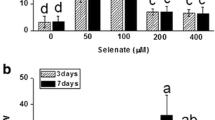Abstract
The marine phytoplankton Dunaliella tertiolecta, Cachonina niei, Thalassiosira nordenskioldii, Phaeodactylum tricornutum, and Chaetoceros sp. were incubated with a range of molar concentrations of sodium-selenite (Na2-SeIVO3) and sodium-selenate (Na2-SeVIO4) to examine further their role in metabolic cycling of selenium in ocean waters. At low selenium concentrations, approaching those found naturally in seawater (10-10 to 10-9 M), all species distinguished between selenite and selenate, and actively concentrated selenite from the incubating medium while only marginally accumulating selenate. At much higher concentrations (10-8 to 10-6 M), selenate was also taken up. At the highest concentration tested, i.e., 10-5 M with C. niei, after an immediate rapid uptake in the first 24 h, the intracellular selenite and selenate levels dropped to about 35 to 50% of the initial peak values. These observations suggest an uptake mechanism in these algae which, at normal ambient concentrations of selenium (10-9 M), preferentially selects selenite and excludes selenate. At much higher concentrations (10-8 M), the mechanism becomes overloaded and both selenium species enter the cells. Intracellularly, selenite became associated primarily with protein and amino acid fractions, in approximately equal proportions, while only ca. 4% of total intracellular selenium was found in the lipid fraction. Trace amounts of selenate that entered the cells, mainly during the first minutes of exposure, also entered the protein and amino acid components, but over time were increasingly associated with the protein fraction only. At the end of a 10-d incubation of algal cells in selenite-spiked medium, less than 25% of total Se in the medium could in fact be identified analytically as selenite. This suggests the presence of a non-selenite metabolite, possibly released back into the medium from the algae.
Similar content being viewed by others
Literature cited
Cutter, G. A. (1982). Selenium in reducing waters. Science, Wash. D.C. 217: 829–831
Cutter, G. A., Bruland, K. W. (1984). The marine biogeochemistry of selenium: a re-evaluation. Limnol. Oceanogr 29: 1179–1192
Foda, A., Vandermeulen, J. H., Wrench, J. J. (1983). Uptake and conversion of selenium by a marine bacterium. Can. J. Fish. aquat. Sci. 40 (Suppl. 2): 215–220
Folch, J., Lees, M., Sloane Stanley, G. H. (1957). A simple method for the isolation and purification of total lipids from animal tissues. J. biol. Chem. 226: 497–509
Guillard, R. R. L., Ryther, J. H. (1962). Studies of marine planktonic diatoms. I. Cyclotella nana Hustedt and Detonula confervacea (Cleve) Gran. Can. J. Microbiol. 8: 229–239
Holm-Hansen, O., Lorenzen, C. J., Holmes, R. W., Strickland, J. D. H. (1965). Fluorometric determination of chlorophyll. J. Cons. int. Explor. Mer. 30: 3–15
Kuroda, R., Seki, T., Misu, Y., Oguma, K., Saito, T. (1979). Anion-exchange behaviourand separation of metal ions on DEAE-cellulose in oxalic acid media. Talanta 26: 211–214
Measures, C. I., Burton, J. D. (1980). The vertical distribution and oxidation states of dissolved selenium in the northeast Atlantic ocean and their relationship to biological processes. Earth planet. Sci. Lett. 46: 385–396
Measures, C. I., McDuff, R. E., Edmond, J. M. (1980). Selenium redox chemistry at Geosecs I re-occupation. Earth planet. Sci. Lett 49: 102–108
Lee, C., Bada, J. L. (1975). Amino acids in equatorial Pacific ocean water. Earth planet. Sci. Lett 26: 61–68
Sandholm, M., Oksanen, H. E., Pesonen, L. (1973). Uptake of selenium by aquatic organisms. Limnol. Oceanogr. 18: 496–499
Siegel, A., Degens, E. T. (1965). Concentration of dissolved amino acids from saline waters by ligand-exchange chromatography. Science, Wash. D.C. 151: 1098–1101
Sugimura, Y., Suzuki, Y., Miyake, Y. (1976). The content of selenium and its chemical form in sea water. J. oceanogr. Soc. Jap. 32: 235–241
Wheeler, A. E., Zingaro, R. A., Irgolic, K. (1982). The effect of selenate, selenite, and sulfate on the growth of six unicellular marine algae. J. exp. mar. Biol. 57: 181–194
Wrench, J. J. (1978). Selenium metabolism in the marine phytoplankters Tetraselmis tetrathele and Dunaliella minuta. Mar. Biol. 49: 231–236
Wrench, J. J., Measures, C. I. (1982). Temporal variations in disolved selenium in a coastal ecosystem. Nature, Lond. 299: 431–433
Yentsch, C. S., Menzel, D. W. (1963). A method for the determination of phytoplankton chlorophyll and phaeophytin by fluorescence. Deep-Sea Res. 10: 221–231
Yoshikuni, N., Kuroda, R. (1977). Anion-exchange behaviour of metals on DEAE-cellulose in hydrochloric acid-acetic acid media. Talanta 24: 163–166
Author information
Authors and Affiliations
Additional information
Communicated by O. Kinne, Oldeldorf/Luhe
Rights and permissions
About this article
Cite this article
Vandermeulen, J.H., Foda, A. Cycling of selenite and selenate in marine phytoplankton. Marine Biology 98, 115–123 (1988). https://doi.org/10.1007/BF00392666
Accepted:
Issue Date:
DOI: https://doi.org/10.1007/BF00392666




